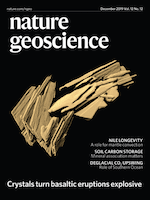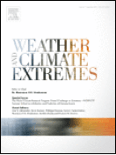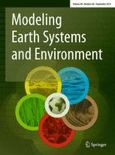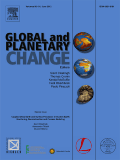
Earth System Dynamics
Scope & Guideline
Connecting Disciplines to Address Global Environmental Challenges
Introduction
Aims and Scopes
- Interdisciplinary Earth System Modeling:
The journal emphasizes the use of advanced modeling techniques to simulate interactions within the Earth system, including climate, biogeochemical cycles, and human impacts. - Climate Change Dynamics:
Research published often explores the dynamics and impacts of climate change, including feedback mechanisms, tipping points, and adaptation strategies across different ecosystems. - Human-Environment Interactions:
A significant focus is placed on understanding how human activities impact natural systems and vice versa, including studies on resource management, land-use changes, and socio-economic implications. - Regional Climate Variability and Extremes:
The journal frequently publishes studies on regional climate variability, extreme weather events, and their implications for ecosystems and human societies. - Innovative Solutions for Sustainability:
Research often discusses innovative solutions to mitigate climate impacts, including geoengineering, carbon management strategies, and sustainable practices.
Trending and Emerging
- Tipping Points and Cascading Effects:
A growing body of research is focusing on tipping points within the Earth system, exploring how small changes can lead to significant and potentially irreversible impacts on global and regional scales. - Socio-Ecological Systems and Resilience:
There is an increasing emphasis on understanding resilience within socio-ecological systems, highlighting the interplay between human and natural systems in the context of climate change. - Advanced Climate Modeling Techniques:
Emerging methodologies in climate modeling, including machine learning and ensemble approaches, are becoming prominent, reflecting advancements in computational capabilities and the need for more accurate predictions. - Geoengineering and Climate Intervention Strategies:
Research into geoengineering solutions and their potential impacts is on the rise, driven by the urgent need to address climate change and the exploration of innovative mitigation strategies. - Carbon Cycle Dynamics and Management:
There is an increasing focus on the carbon cycle, particularly in relation to land-use changes, carbon sequestration, and the implications of anthropogenic activities on carbon dynamics.
Declining or Waning
- Historical Climate Reconstructions:
Research focusing on detailed historical climate reconstructions appears to be waning, possibly as the field shifts towards more forward-looking studies on future climate scenarios and impacts. - Localized Studies on Specific Ecosystems:
While localized studies were once prevalent, there seems to be a trend moving towards broader, more integrative studies that encompass multiple systems or large-scale impacts rather than focusing solely on individual ecosystems. - Traditional Climate Impact Assessments:
There is a noticeable decline in traditional impact assessments that do not incorporate complex interactions or system dynamics, as the journal increasingly favors studies that utilize advanced modeling or interdisciplinary approaches.
Similar Journals

Nature Geoscience
Connecting Research to Global Challenges.Nature Geoscience, a premier journal published by NATURE PORTFOLIO, provides a platform for the dissemination of high-quality research in Earth and Planetary Sciences. With an impressive impact factor reflecting its significance — ranking in the 99th percentile and positioned at #1 out of 195 in Scopus Ranks within its category, this journal is a leading authority in its field. Since its inception in 2008, it has fostered interdisciplinary collaboration, addressing critical challenges such as climate change, natural disasters, and resource management. Although it does not offer Open Access, the journal is accessible through various research libraries, ensuring that vital findings reach a broad audience. The journal's esteemed reputation in the Q1 quartile of Earth and Planetary Sciences makes it an essential resource for researchers, professionals, and students aiming to advance their understanding of geoscientific phenomena.

Earth System Governance
Connecting Disciplines to Tackle Global IssuesEarth System Governance, published by ELSEVIER, is a leading open-access journal first launched in 2019 and is based in the Netherlands. With its ISSN 2589-8116, this journal has rapidly established itself as an essential resource in multiple disciplines, achieving impressive rankings within the Q1 category across various fields including Geography, Planning and Development, Global and Planetary Change, Political Science, and more. The journal is notable for its dedication to advancing the understanding of governance in relation to complex environmental challenges, making it a vital platform for researchers and practitioners focused on sustainable development and policy-making. Notably, Earth System Governance boasts a high impact factor and ranks in the top percentiles of its categories, highlighting its relevance and significance in contemporary academic discourse. With an open-access model, it ensures that cutting-edge research is readily available to a global audience, promoting collaboration and innovation in tackling pressing global issues.

Weather and Climate Extremes
Exploring the Frontiers of Weather Extremes and Their ImpactsWeather and Climate Extremes is a premier open access journal published by Elsevier, dedicated to advancing the understanding of extreme weather and climate phenomena from 2013 onwards. With an impressive impact factor, this journal ranks in the Q1 quartile across several categories including Atmospheric Science and Geography, Planning and Development, highlighting its significance in the field. The journal serves as a vital platform for researchers, professionals, and students, enabling them to disseminate their findings on climate variability, response strategies, and policy implications. Its accessibility ensures a wide reach, fostering collaboration and innovation while building a comprehensive repository of knowledge to address the challenges posed by climate extremes. The journal’s commitment to quality research is reflected in its Scopus rankings, with top placements across multiple disciplines, signaling its influence in shaping the discourse on climate and ecological management.

Annual Review of Earth and Planetary Sciences
Unlocking the Secrets of Our Planetary NeighborsAnnual Review of Earth and Planetary Sciences is a leading scholarly journal published by Annual Reviews, dedicated to advancing our understanding of the dynamic processes governing the Earth and its celestial companions. With ISSN 0084-6597 and E-ISSN 1545-4495, this esteemed journal, established in 1976, has consistently provided comprehensive reviews that synthesize cutting-edge research across various disciplines, including astronomy, astrobiology, geology, and planetary science. Notably, the journal has achieved a remarkable position in the academic landscape, ranking in the Q1 quartile across multiple categories, including Astronomy and Astrophysics and Earth and Planetary Sciences, with Scopus rankings placing it at the forefront of these fields. The journal's commitment to facilitating open access to critical scientific advances, though not fully open, allows for maximum reach within the research community. Researchers, professionals, and students alike can benefit from the high-impact articles designed to foster collaboration and innovation within the fields of earth and planetary science.

Modeling Earth Systems and Environment
Bridging theory and application for a sustainable future.Modeling Earth Systems and Environment is a premier interdisciplinary journal published by Springer Heidelberg, dedicated to advancing the understanding and modeling of Earth's systems and environmental processes. Since its inception in 2015, this journal has established itself as a vital resource within the academic community, attaining a Q1 ranking in Agricultural and Biological Sciences and Q2 rankings in Computers in Earth Sciences, Environmental Science, and Statistics, reflecting its high impact and relevance across multiple disciplines. Featuring rigorous peer-reviewed research, Modeling Earth Systems and Environment aims to bridge the gap between theory and practical application, fostering collaboration among researchers, professionals, and students alike. With access options that prioritize the dissemination of knowledge, this journal is crucial for those seeking to contribute to the fields of environmental modeling and systems science, encouraging innovations that address contemporary environmental challenges.

Journal of Southern Hemisphere Earth Systems Science
Empowering Scholarship for a Resilient Planet.The Journal of Southern Hemisphere Earth Systems Science, published by CSIRO PUBLISHING, stands as a pivotal resource for researchers and professionals in the fields of Atmospheric Science, Global and Planetary Change, and Oceanography. Established in 2016 and operating under an Open Access model since 2019, this journal provides a platform for innovative research and critical discourse on earth systems in the Southern Hemisphere. It has achieved impressive rankings with a Q1 classification across key disciplines and is recognized in Scopus with significant percentile rankings, showcasing its influence and relevance within the scientific community. The journal is dedicated to fostering scholarship that addresses the complex interactions of earth systems, offering valuable insights for those engaged in environmental science and sustainability initiatives. Its commitment to facilitating open access resources makes it an invaluable tool for researchers and students alike, striving to enhance our understanding of global environmental changes.

GLOBAL AND PLANETARY CHANGE
Illuminating the Path to Global Environmental SolutionsGLOBAL AND PLANETARY CHANGE, published by Elsevier, is a premier international journal focused on the critical issues surrounding environmental science, climate change, and planetary dynamics. Since its inception in 1989, this journal has established itself as a leading voice in the field, currently holding a prestigious Q1 ranking in both Global and Planetary Change and Oceanography as of 2023. With a remarkable influence reflected in its Scopus rankings—15th in Earth and Planetary Sciences and 34th in Global and Planetary Change—it serves as an essential platform for researchers, professionals, and students. The journal provides a comprehensive examination of cutting-edge research findings and innovative developments that address the urgent challenges facing our planet. Although it is not an Open Access journal, it remains a vital resource for anyone keen to contribute to or stay informed on the ever-evolving discourse of global environmental change, promoting sustainable solutions for the future.

Carbon Balance and Management
Leading the charge in carbon balance research.Carbon Balance and Management is a prestigious open-access journal published by BMC, focusing on the critical areas of carbon management, environmental science, and global change. Since its inception in 2006, the journal has contributed significantly to advancing research within the realms of Earth and Planetary Sciences, Environmental Management, and Policy, gaining recognition for its high-impact studies, as evidenced by its Q1 status in multiple categories, including Earth and Planetary Sciences and Management, Monitoring, Policy and Law. With an impressive ranking within the 91st percentile among Earth and Planetary Sciences journals, it stands as a vital resource for researchers, professionals, and students dedicated to understanding and addressing the complexities of carbon balance and sustainability. The journal embraces a broad scope of interdisciplinary research, catalyzing impactful solutions to pressing environmental challenges and fostering collaboration across scientific communities. The commitment to open access allows for wider dissemination of knowledge, ensuring that critical findings reach a diverse audience globally. Whether you're aiming to contribute original research, review existing literature, or simply stay informed, Carbon Balance and Management serves as an essential platform for fostering advancements in carbon management strategies and climate policy.

Carpathian Journal of Earth and Environmental Sciences
Championing High-Quality Research in Earth SciencesCarpathian Journal of Earth and Environmental Sciences is a distinguished academic journal dedicated to advancing the interdisciplinary field of Earth and environmental sciences. Published by the Carpathian Association for Environment and Earth Sciences, this journal plays a pivotal role in disseminating high-quality research focused on the dynamic interactions between geological processes and environmental changes. With an ISSN of 1842-4090 and an E-ISSN of 1844-489X, the journal is indexed in Scopus and holds an esteemed Q3 quartile ranking in both Earth and Planetary Sciences and Environmental Science categories as of 2023. Since its inception in 2008, the Carpathian Journal has provided an open access platform for researchers, professionals, and students to share insights, foster collaboration, and engage in critical discussions on pressing environmental issues. By continuously contributing to the body of knowledge in this field, the journal not only enhances academic discourse but also promotes sustainable environmental practices across Romania and beyond.

All Earth
Empowering Research for Planetary ChangeAll Earth is an esteemed open-access journal published by Taylor & Francis Ltd, dedicated to multidisciplinary research in the fields of Earth and Planetary Sciences, Global and Planetary Change, as well as Management, Monitoring, Policy, and Law. Since its inception in 2021, All Earth has swiftly positioned itself in the academic community, achieving notable rankings such as Q2 in Earth and Planetary Sciences and Q3 in related fields, showcasing its commitment to high-quality interdisciplinary scholarship. Researchers and professionals can benefit from its accessible content, which contributes to the ongoing discourse on critical environmental issues and innovative solutions for sustainable development. The journal is based in the United Kingdom and continues to be a vital source of information and inspiration for students and scholars aiming to tackle the pressing challenges of our planet through rigorous scientific inquiry and policy analysis.